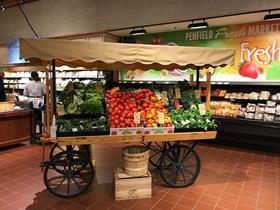
Environmental concerns are a global hot topic, and when you can drag your attention away from Trump and Brexit for long enough, efforts to increase loose merchandising on either side of the Atlantic come back into focus.
Some of the methods used in the US, such as misting, have been seen in Whole Foods in the UK for some time. American retailers spend more money on staff to make this a reality and employees are trained to monitor product quality, remove sub-par product from sale, and ensure rotation. However, ‘stock rolling’, where the dregs of an old case get dumped into the new one, can cause quality issues.
In the UK, by contrast, stock is managed more efficiently and most of it is decanted onto the shelf, so the process is continuous. Accepted and budgeted-for waste levels are higher in the US.
One of my favourite mechanisms for prolonging shelf life of loose product is the use of troughs: black plastic, metre-long troughs with removable liners that can be stacked vertically. They are used in both ambient and chilled fixtures and products are merchandised vertically, with their ‘butts’ sitting in the water at the bottom of the trough.
These obviously present challenges from a microbiological perspective: where does the water come from? How frequently is it rotated? What are the testing frequencies etc? But purely from a consumer perspective there is a strong visual impact. Tiered purple, white and green asparagus bunches are striking, and vibrant Romaine, Batavia and red oak-leaf lettuce varieties, all showing off their ‘best side’ and looking leafy and luscious, are impactful. If managed correctly, these products’ shelf life is extended compared to what it would be if they were simply piled on top of one anther on a misted shelf.
The environmental positives of such an approach are somewhat negated by American retailers’ propensity to place said items into a plastic bag. Then a nice cashier will “double bag that so it doesn’t drip everywhere”.
American retailers think stacking produce in troughs looks pretty – they are right. But in the US, the environment is rarely a primary motivator. This doesn’t have to the case, as UK retailers like Sainsbury’s are demonstrating.






No comments yet